Medibank's Revaluation and Impairment Testing Report (ACCT20073)
VerifiedAdded on 2023/01/13
|9
|2971
|64
Report
AI Summary
This report analyzes the concepts of revaluation and impairment testing of non-current assets, focusing on the application of these principles within Medibank's 2018 Annual Report. The report begins by exploring the revaluation model, considering its advantages and disadvantages, and recommending its adoption. It then addresses the importance of impairment testing in conjunction with revaluation, emphasizing the need to ensure assets are not carried at amounts exceeding their recoverable value. The core of the report examines Medibank's financial reporting practices, including its use of fair value measurement in accordance with AASB 13/IFRS 13, detailing the assets measured at fair value and the fair value hierarchy. It investigates Medibank's compliance with these standards, including disclosure requirements. Finally, the report identifies the assets Medibank tests for impairment, the accounting policies adopted for impairment, and the application of AASB 136/IAS 39, concluding that Medibank complies with all relevant standards and provides necessary disclosures. This report provides a comprehensive overview of how these crucial accounting principles are applied in practice.
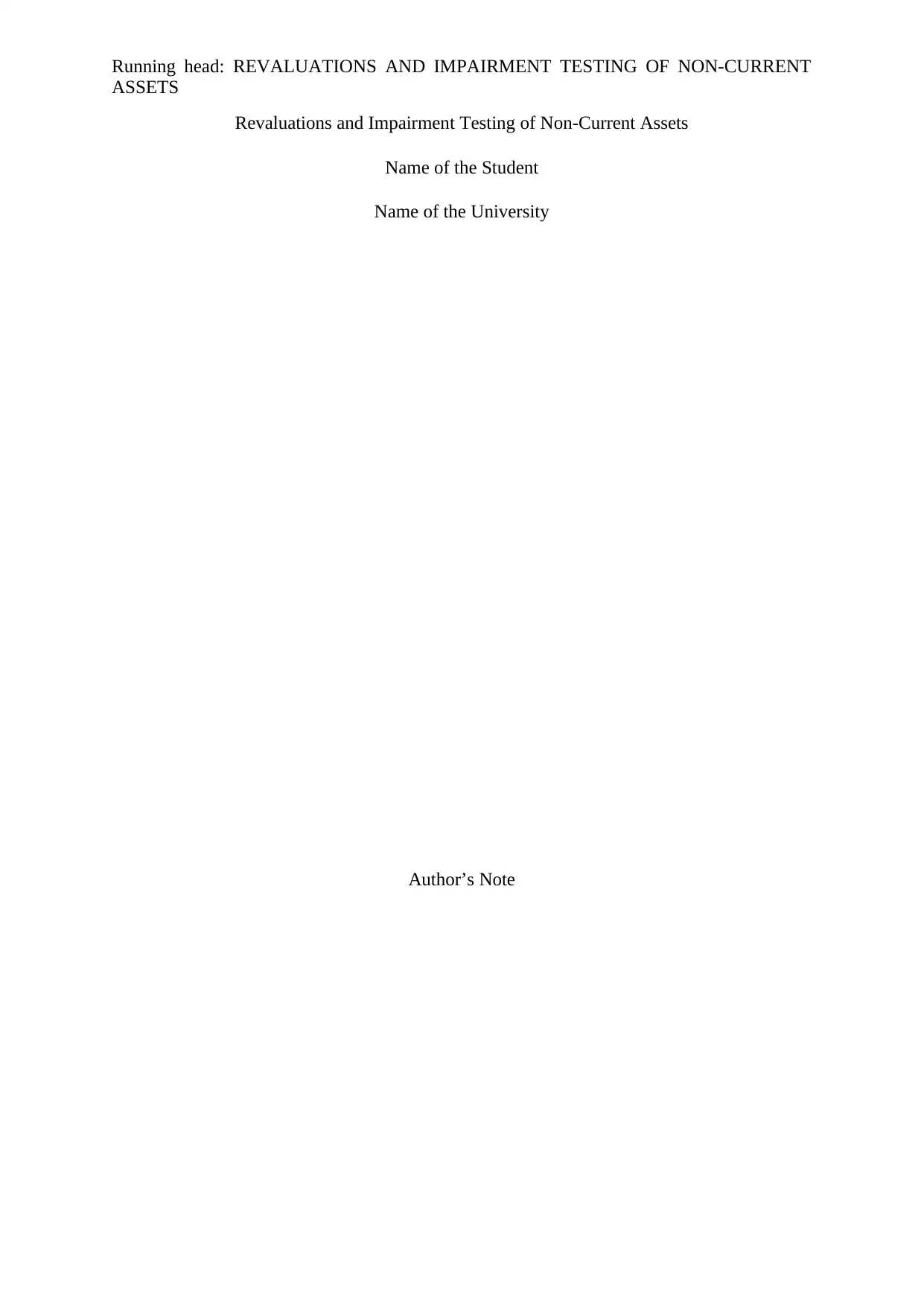
Running head: REVALUATIONS AND IMPAIRMENT TESTING OF NON-CURRENT
ASSETS
Revaluations and Impairment Testing of Non-Current Assets
Name of the Student
Name of the University
Author’s Note
ASSETS
Revaluations and Impairment Testing of Non-Current Assets
Name of the Student
Name of the University
Author’s Note
Paraphrase This Document
Need a fresh take? Get an instant paraphrase of this document with our AI Paraphraser
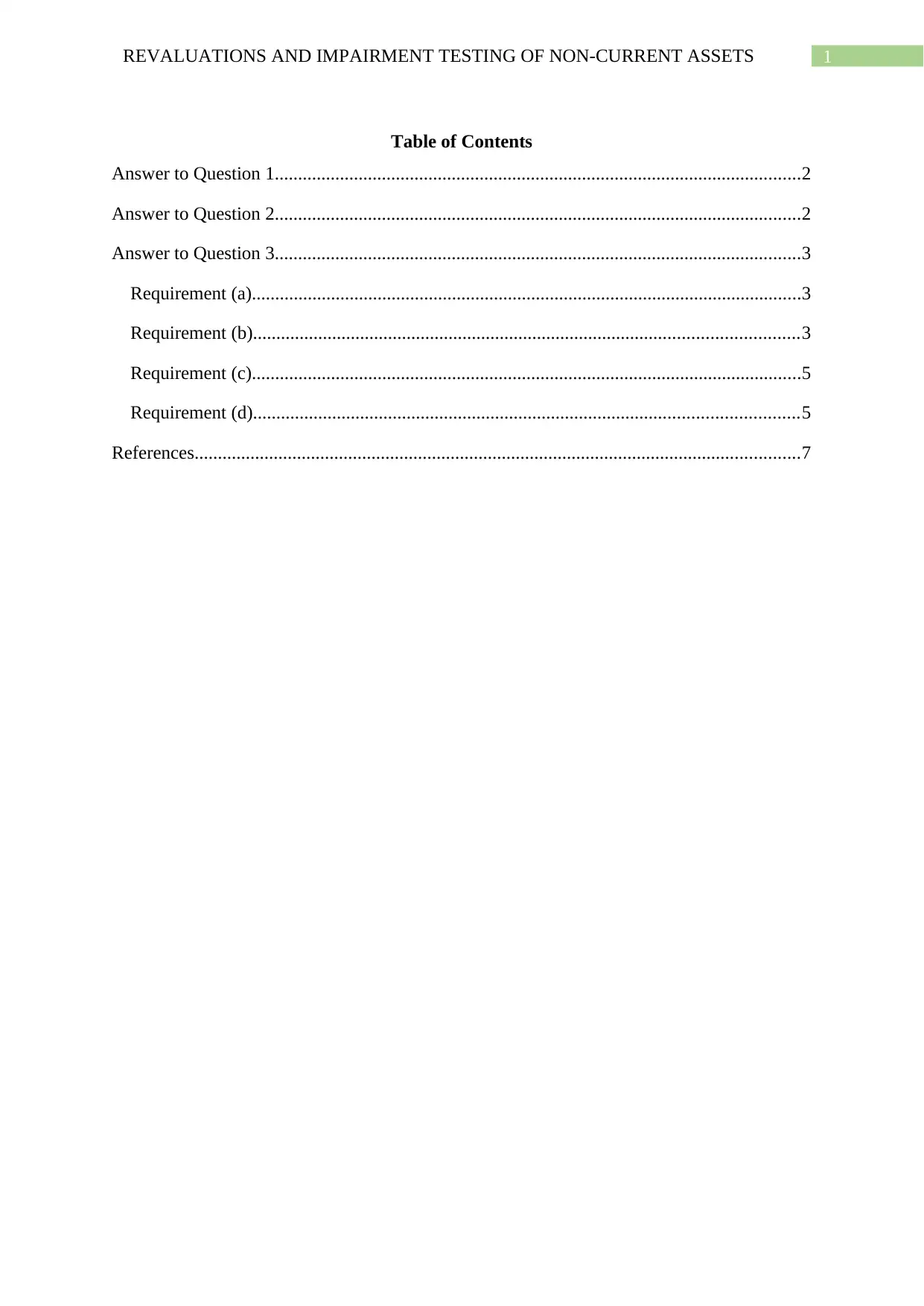
1REVALUATIONS AND IMPAIRMENT TESTING OF NON-CURRENT ASSETS
Table of Contents
Answer to Question 1.................................................................................................................2
Answer to Question 2.................................................................................................................2
Answer to Question 3.................................................................................................................3
Requirement (a)......................................................................................................................3
Requirement (b).....................................................................................................................3
Requirement (c)......................................................................................................................5
Requirement (d).....................................................................................................................5
References..................................................................................................................................7
Table of Contents
Answer to Question 1.................................................................................................................2
Answer to Question 2.................................................................................................................2
Answer to Question 3.................................................................................................................3
Requirement (a)......................................................................................................................3
Requirement (b).....................................................................................................................3
Requirement (c)......................................................................................................................5
Requirement (d).....................................................................................................................5
References..................................................................................................................................7
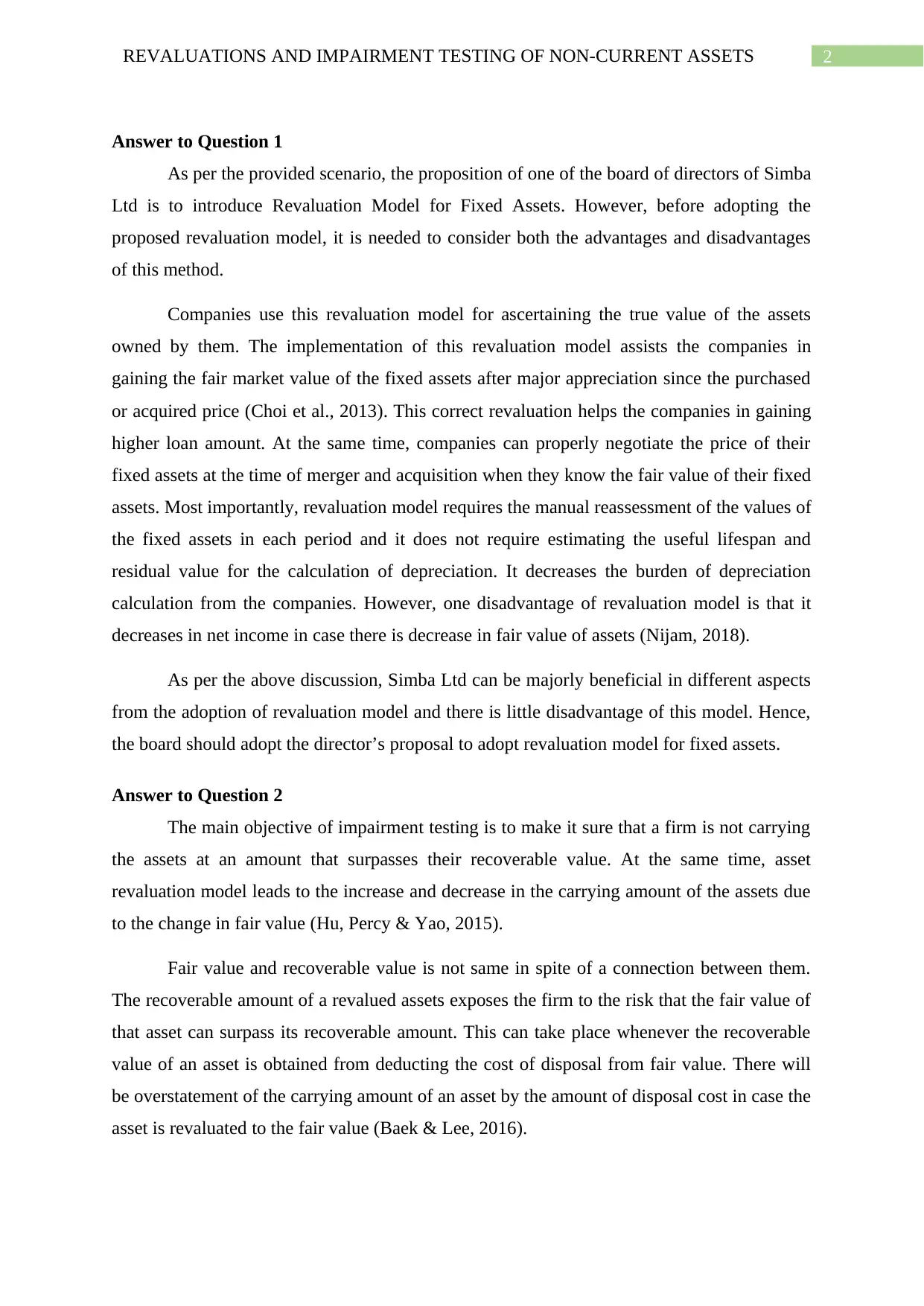
2REVALUATIONS AND IMPAIRMENT TESTING OF NON-CURRENT ASSETS
Answer to Question 1
As per the provided scenario, the proposition of one of the board of directors of Simba
Ltd is to introduce Revaluation Model for Fixed Assets. However, before adopting the
proposed revaluation model, it is needed to consider both the advantages and disadvantages
of this method.
Companies use this revaluation model for ascertaining the true value of the assets
owned by them. The implementation of this revaluation model assists the companies in
gaining the fair market value of the fixed assets after major appreciation since the purchased
or acquired price (Choi et al., 2013). This correct revaluation helps the companies in gaining
higher loan amount. At the same time, companies can properly negotiate the price of their
fixed assets at the time of merger and acquisition when they know the fair value of their fixed
assets. Most importantly, revaluation model requires the manual reassessment of the values of
the fixed assets in each period and it does not require estimating the useful lifespan and
residual value for the calculation of depreciation. It decreases the burden of depreciation
calculation from the companies. However, one disadvantage of revaluation model is that it
decreases in net income in case there is decrease in fair value of assets (Nijam, 2018).
As per the above discussion, Simba Ltd can be majorly beneficial in different aspects
from the adoption of revaluation model and there is little disadvantage of this model. Hence,
the board should adopt the director’s proposal to adopt revaluation model for fixed assets.
Answer to Question 2
The main objective of impairment testing is to make it sure that a firm is not carrying
the assets at an amount that surpasses their recoverable value. At the same time, asset
revaluation model leads to the increase and decrease in the carrying amount of the assets due
to the change in fair value (Hu, Percy & Yao, 2015).
Fair value and recoverable value is not same in spite of a connection between them.
The recoverable amount of a revalued assets exposes the firm to the risk that the fair value of
that asset can surpass its recoverable amount. This can take place whenever the recoverable
value of an asset is obtained from deducting the cost of disposal from fair value. There will
be overstatement of the carrying amount of an asset by the amount of disposal cost in case the
asset is revaluated to the fair value (Baek & Lee, 2016).
Answer to Question 1
As per the provided scenario, the proposition of one of the board of directors of Simba
Ltd is to introduce Revaluation Model for Fixed Assets. However, before adopting the
proposed revaluation model, it is needed to consider both the advantages and disadvantages
of this method.
Companies use this revaluation model for ascertaining the true value of the assets
owned by them. The implementation of this revaluation model assists the companies in
gaining the fair market value of the fixed assets after major appreciation since the purchased
or acquired price (Choi et al., 2013). This correct revaluation helps the companies in gaining
higher loan amount. At the same time, companies can properly negotiate the price of their
fixed assets at the time of merger and acquisition when they know the fair value of their fixed
assets. Most importantly, revaluation model requires the manual reassessment of the values of
the fixed assets in each period and it does not require estimating the useful lifespan and
residual value for the calculation of depreciation. It decreases the burden of depreciation
calculation from the companies. However, one disadvantage of revaluation model is that it
decreases in net income in case there is decrease in fair value of assets (Nijam, 2018).
As per the above discussion, Simba Ltd can be majorly beneficial in different aspects
from the adoption of revaluation model and there is little disadvantage of this model. Hence,
the board should adopt the director’s proposal to adopt revaluation model for fixed assets.
Answer to Question 2
The main objective of impairment testing is to make it sure that a firm is not carrying
the assets at an amount that surpasses their recoverable value. At the same time, asset
revaluation model leads to the increase and decrease in the carrying amount of the assets due
to the change in fair value (Hu, Percy & Yao, 2015).
Fair value and recoverable value is not same in spite of a connection between them.
The recoverable amount of a revalued assets exposes the firm to the risk that the fair value of
that asset can surpass its recoverable amount. This can take place whenever the recoverable
value of an asset is obtained from deducting the cost of disposal from fair value. There will
be overstatement of the carrying amount of an asset by the amount of disposal cost in case the
asset is revaluated to the fair value (Baek & Lee, 2016).
⊘ This is a preview!⊘
Do you want full access?
Subscribe today to unlock all pages.

Trusted by 1+ million students worldwide
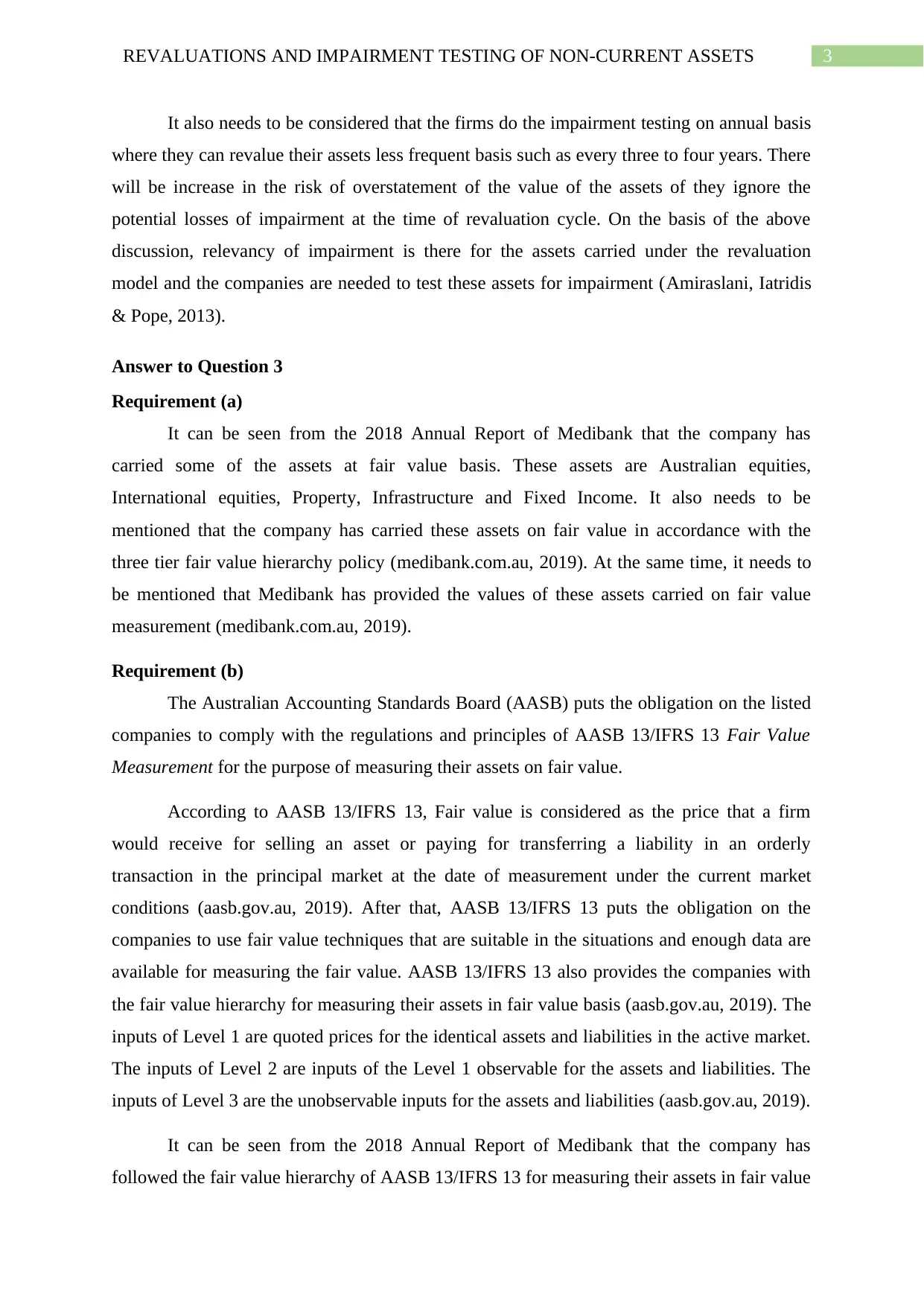
3REVALUATIONS AND IMPAIRMENT TESTING OF NON-CURRENT ASSETS
It also needs to be considered that the firms do the impairment testing on annual basis
where they can revalue their assets less frequent basis such as every three to four years. There
will be increase in the risk of overstatement of the value of the assets of they ignore the
potential losses of impairment at the time of revaluation cycle. On the basis of the above
discussion, relevancy of impairment is there for the assets carried under the revaluation
model and the companies are needed to test these assets for impairment (Amiraslani, Iatridis
& Pope, 2013).
Answer to Question 3
Requirement (a)
It can be seen from the 2018 Annual Report of Medibank that the company has
carried some of the assets at fair value basis. These assets are Australian equities,
International equities, Property, Infrastructure and Fixed Income. It also needs to be
mentioned that the company has carried these assets on fair value in accordance with the
three tier fair value hierarchy policy (medibank.com.au, 2019). At the same time, it needs to
be mentioned that Medibank has provided the values of these assets carried on fair value
measurement (medibank.com.au, 2019).
Requirement (b)
The Australian Accounting Standards Board (AASB) puts the obligation on the listed
companies to comply with the regulations and principles of AASB 13/IFRS 13 Fair Value
Measurement for the purpose of measuring their assets on fair value.
According to AASB 13/IFRS 13, Fair value is considered as the price that a firm
would receive for selling an asset or paying for transferring a liability in an orderly
transaction in the principal market at the date of measurement under the current market
conditions (aasb.gov.au, 2019). After that, AASB 13/IFRS 13 puts the obligation on the
companies to use fair value techniques that are suitable in the situations and enough data are
available for measuring the fair value. AASB 13/IFRS 13 also provides the companies with
the fair value hierarchy for measuring their assets in fair value basis (aasb.gov.au, 2019). The
inputs of Level 1 are quoted prices for the identical assets and liabilities in the active market.
The inputs of Level 2 are inputs of the Level 1 observable for the assets and liabilities. The
inputs of Level 3 are the unobservable inputs for the assets and liabilities (aasb.gov.au, 2019).
It can be seen from the 2018 Annual Report of Medibank that the company has
followed the fair value hierarchy of AASB 13/IFRS 13 for measuring their assets in fair value
It also needs to be considered that the firms do the impairment testing on annual basis
where they can revalue their assets less frequent basis such as every three to four years. There
will be increase in the risk of overstatement of the value of the assets of they ignore the
potential losses of impairment at the time of revaluation cycle. On the basis of the above
discussion, relevancy of impairment is there for the assets carried under the revaluation
model and the companies are needed to test these assets for impairment (Amiraslani, Iatridis
& Pope, 2013).
Answer to Question 3
Requirement (a)
It can be seen from the 2018 Annual Report of Medibank that the company has
carried some of the assets at fair value basis. These assets are Australian equities,
International equities, Property, Infrastructure and Fixed Income. It also needs to be
mentioned that the company has carried these assets on fair value in accordance with the
three tier fair value hierarchy policy (medibank.com.au, 2019). At the same time, it needs to
be mentioned that Medibank has provided the values of these assets carried on fair value
measurement (medibank.com.au, 2019).
Requirement (b)
The Australian Accounting Standards Board (AASB) puts the obligation on the listed
companies to comply with the regulations and principles of AASB 13/IFRS 13 Fair Value
Measurement for the purpose of measuring their assets on fair value.
According to AASB 13/IFRS 13, Fair value is considered as the price that a firm
would receive for selling an asset or paying for transferring a liability in an orderly
transaction in the principal market at the date of measurement under the current market
conditions (aasb.gov.au, 2019). After that, AASB 13/IFRS 13 puts the obligation on the
companies to use fair value techniques that are suitable in the situations and enough data are
available for measuring the fair value. AASB 13/IFRS 13 also provides the companies with
the fair value hierarchy for measuring their assets in fair value basis (aasb.gov.au, 2019). The
inputs of Level 1 are quoted prices for the identical assets and liabilities in the active market.
The inputs of Level 2 are inputs of the Level 1 observable for the assets and liabilities. The
inputs of Level 3 are the unobservable inputs for the assets and liabilities (aasb.gov.au, 2019).
It can be seen from the 2018 Annual Report of Medibank that the company has
followed the fair value hierarchy of AASB 13/IFRS 13 for measuring their assets in fair value
Paraphrase This Document
Need a fresh take? Get an instant paraphrase of this document with our AI Paraphraser
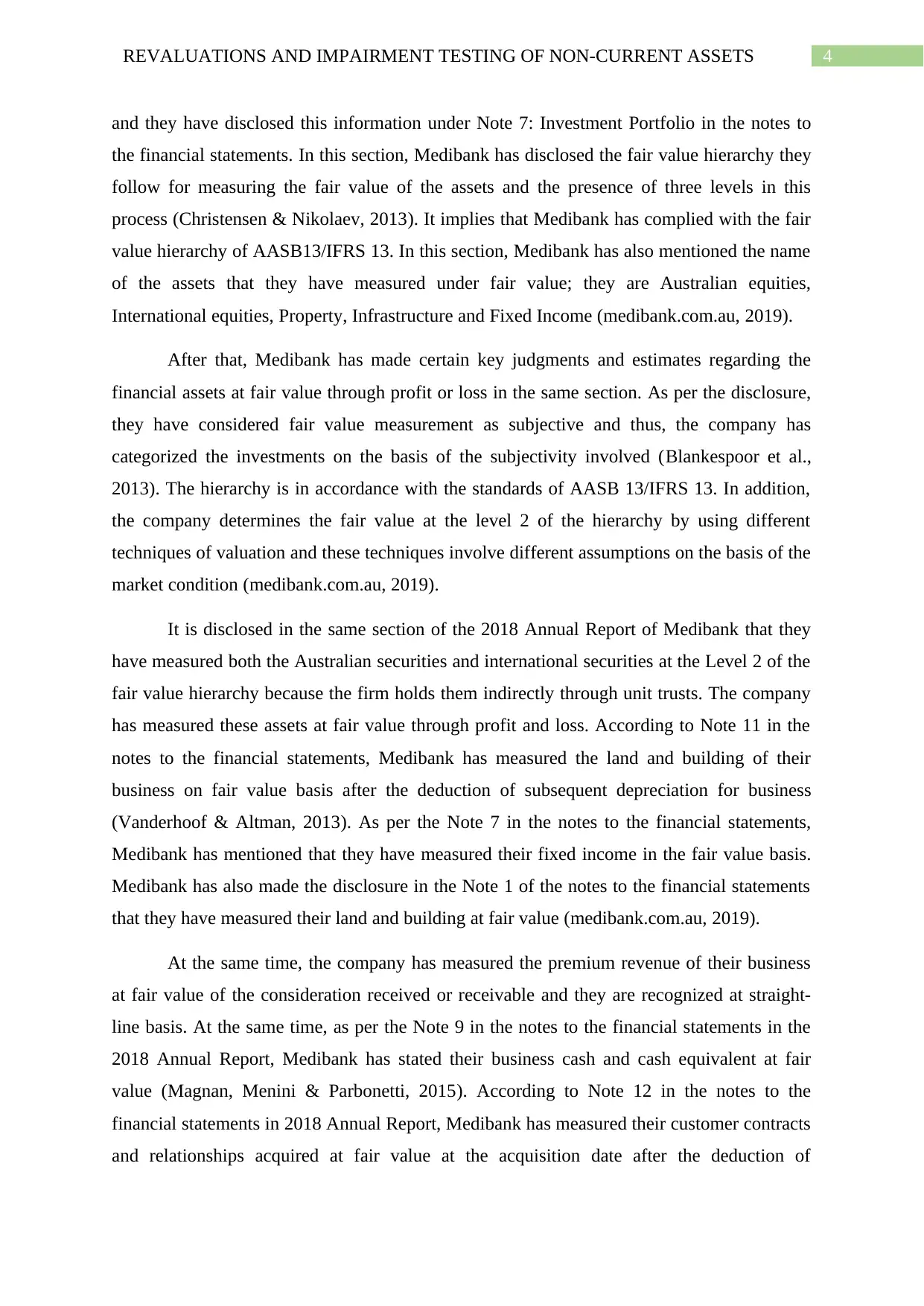
4REVALUATIONS AND IMPAIRMENT TESTING OF NON-CURRENT ASSETS
and they have disclosed this information under Note 7: Investment Portfolio in the notes to
the financial statements. In this section, Medibank has disclosed the fair value hierarchy they
follow for measuring the fair value of the assets and the presence of three levels in this
process (Christensen & Nikolaev, 2013). It implies that Medibank has complied with the fair
value hierarchy of AASB13/IFRS 13. In this section, Medibank has also mentioned the name
of the assets that they have measured under fair value; they are Australian equities,
International equities, Property, Infrastructure and Fixed Income (medibank.com.au, 2019).
After that, Medibank has made certain key judgments and estimates regarding the
financial assets at fair value through profit or loss in the same section. As per the disclosure,
they have considered fair value measurement as subjective and thus, the company has
categorized the investments on the basis of the subjectivity involved (Blankespoor et al.,
2013). The hierarchy is in accordance with the standards of AASB 13/IFRS 13. In addition,
the company determines the fair value at the level 2 of the hierarchy by using different
techniques of valuation and these techniques involve different assumptions on the basis of the
market condition (medibank.com.au, 2019).
It is disclosed in the same section of the 2018 Annual Report of Medibank that they
have measured both the Australian securities and international securities at the Level 2 of the
fair value hierarchy because the firm holds them indirectly through unit trusts. The company
has measured these assets at fair value through profit and loss. According to Note 11 in the
notes to the financial statements, Medibank has measured the land and building of their
business on fair value basis after the deduction of subsequent depreciation for business
(Vanderhoof & Altman, 2013). As per the Note 7 in the notes to the financial statements,
Medibank has mentioned that they have measured their fixed income in the fair value basis.
Medibank has also made the disclosure in the Note 1 of the notes to the financial statements
that they have measured their land and building at fair value (medibank.com.au, 2019).
At the same time, the company has measured the premium revenue of their business
at fair value of the consideration received or receivable and they are recognized at straight-
line basis. At the same time, as per the Note 9 in the notes to the financial statements in the
2018 Annual Report, Medibank has stated their business cash and cash equivalent at fair
value (Magnan, Menini & Parbonetti, 2015). According to Note 12 in the notes to the
financial statements in 2018 Annual Report, Medibank has measured their customer contracts
and relationships acquired at fair value at the acquisition date after the deduction of
and they have disclosed this information under Note 7: Investment Portfolio in the notes to
the financial statements. In this section, Medibank has disclosed the fair value hierarchy they
follow for measuring the fair value of the assets and the presence of three levels in this
process (Christensen & Nikolaev, 2013). It implies that Medibank has complied with the fair
value hierarchy of AASB13/IFRS 13. In this section, Medibank has also mentioned the name
of the assets that they have measured under fair value; they are Australian equities,
International equities, Property, Infrastructure and Fixed Income (medibank.com.au, 2019).
After that, Medibank has made certain key judgments and estimates regarding the
financial assets at fair value through profit or loss in the same section. As per the disclosure,
they have considered fair value measurement as subjective and thus, the company has
categorized the investments on the basis of the subjectivity involved (Blankespoor et al.,
2013). The hierarchy is in accordance with the standards of AASB 13/IFRS 13. In addition,
the company determines the fair value at the level 2 of the hierarchy by using different
techniques of valuation and these techniques involve different assumptions on the basis of the
market condition (medibank.com.au, 2019).
It is disclosed in the same section of the 2018 Annual Report of Medibank that they
have measured both the Australian securities and international securities at the Level 2 of the
fair value hierarchy because the firm holds them indirectly through unit trusts. The company
has measured these assets at fair value through profit and loss. According to Note 11 in the
notes to the financial statements, Medibank has measured the land and building of their
business on fair value basis after the deduction of subsequent depreciation for business
(Vanderhoof & Altman, 2013). As per the Note 7 in the notes to the financial statements,
Medibank has mentioned that they have measured their fixed income in the fair value basis.
Medibank has also made the disclosure in the Note 1 of the notes to the financial statements
that they have measured their land and building at fair value (medibank.com.au, 2019).
At the same time, the company has measured the premium revenue of their business
at fair value of the consideration received or receivable and they are recognized at straight-
line basis. At the same time, as per the Note 9 in the notes to the financial statements in the
2018 Annual Report, Medibank has stated their business cash and cash equivalent at fair
value (Magnan, Menini & Parbonetti, 2015). According to Note 12 in the notes to the
financial statements in 2018 Annual Report, Medibank has measured their customer contracts
and relationships acquired at fair value at the acquisition date after the deduction of
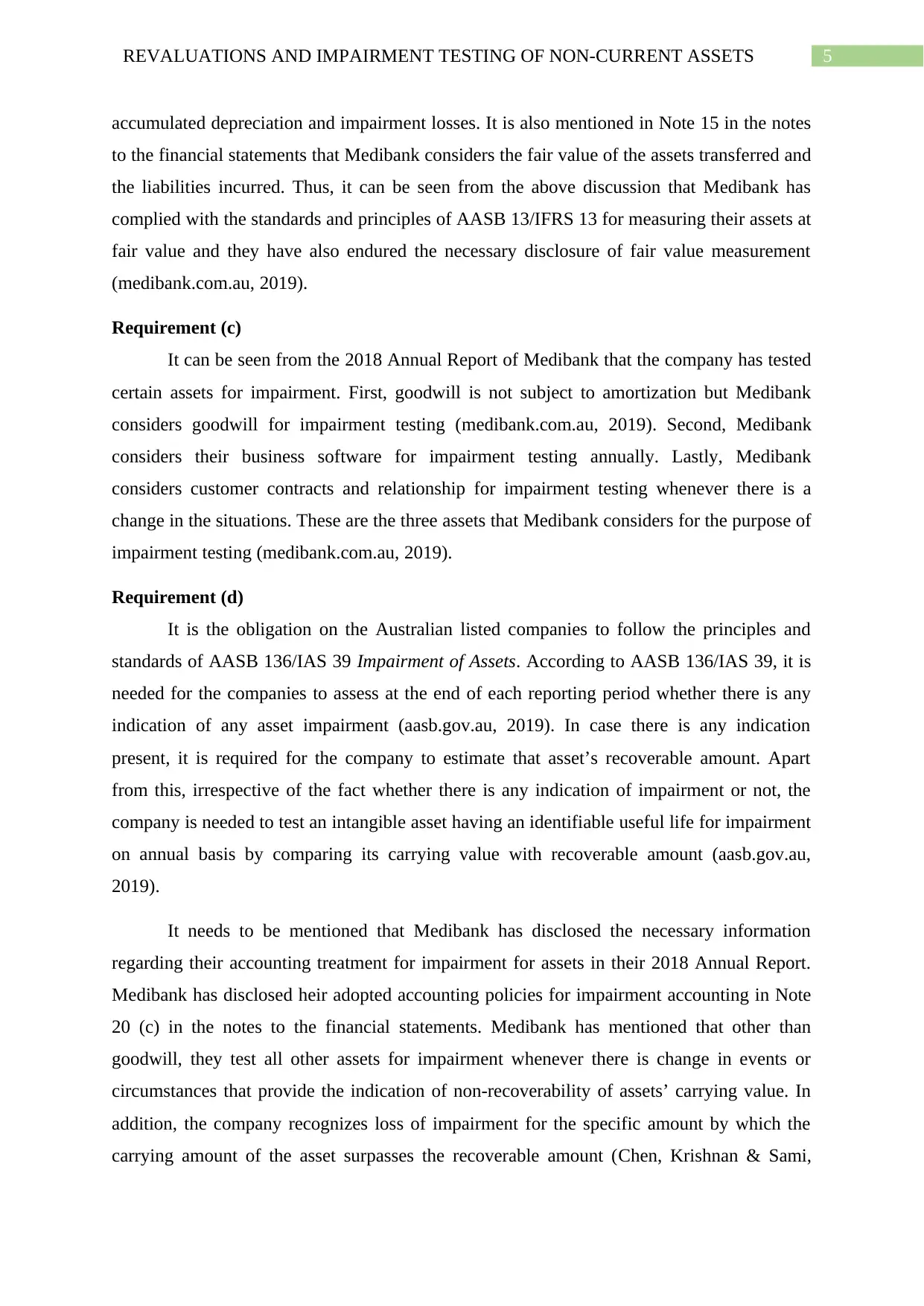
5REVALUATIONS AND IMPAIRMENT TESTING OF NON-CURRENT ASSETS
accumulated depreciation and impairment losses. It is also mentioned in Note 15 in the notes
to the financial statements that Medibank considers the fair value of the assets transferred and
the liabilities incurred. Thus, it can be seen from the above discussion that Medibank has
complied with the standards and principles of AASB 13/IFRS 13 for measuring their assets at
fair value and they have also endured the necessary disclosure of fair value measurement
(medibank.com.au, 2019).
Requirement (c)
It can be seen from the 2018 Annual Report of Medibank that the company has tested
certain assets for impairment. First, goodwill is not subject to amortization but Medibank
considers goodwill for impairment testing (medibank.com.au, 2019). Second, Medibank
considers their business software for impairment testing annually. Lastly, Medibank
considers customer contracts and relationship for impairment testing whenever there is a
change in the situations. These are the three assets that Medibank considers for the purpose of
impairment testing (medibank.com.au, 2019).
Requirement (d)
It is the obligation on the Australian listed companies to follow the principles and
standards of AASB 136/IAS 39 Impairment of Assets. According to AASB 136/IAS 39, it is
needed for the companies to assess at the end of each reporting period whether there is any
indication of any asset impairment (aasb.gov.au, 2019). In case there is any indication
present, it is required for the company to estimate that asset’s recoverable amount. Apart
from this, irrespective of the fact whether there is any indication of impairment or not, the
company is needed to test an intangible asset having an identifiable useful life for impairment
on annual basis by comparing its carrying value with recoverable amount (aasb.gov.au,
2019).
It needs to be mentioned that Medibank has disclosed the necessary information
regarding their accounting treatment for impairment for assets in their 2018 Annual Report.
Medibank has disclosed heir adopted accounting policies for impairment accounting in Note
20 (c) in the notes to the financial statements. Medibank has mentioned that other than
goodwill, they test all other assets for impairment whenever there is change in events or
circumstances that provide the indication of non-recoverability of assets’ carrying value. In
addition, the company recognizes loss of impairment for the specific amount by which the
carrying amount of the asset surpasses the recoverable amount (Chen, Krishnan & Sami,
accumulated depreciation and impairment losses. It is also mentioned in Note 15 in the notes
to the financial statements that Medibank considers the fair value of the assets transferred and
the liabilities incurred. Thus, it can be seen from the above discussion that Medibank has
complied with the standards and principles of AASB 13/IFRS 13 for measuring their assets at
fair value and they have also endured the necessary disclosure of fair value measurement
(medibank.com.au, 2019).
Requirement (c)
It can be seen from the 2018 Annual Report of Medibank that the company has tested
certain assets for impairment. First, goodwill is not subject to amortization but Medibank
considers goodwill for impairment testing (medibank.com.au, 2019). Second, Medibank
considers their business software for impairment testing annually. Lastly, Medibank
considers customer contracts and relationship for impairment testing whenever there is a
change in the situations. These are the three assets that Medibank considers for the purpose of
impairment testing (medibank.com.au, 2019).
Requirement (d)
It is the obligation on the Australian listed companies to follow the principles and
standards of AASB 136/IAS 39 Impairment of Assets. According to AASB 136/IAS 39, it is
needed for the companies to assess at the end of each reporting period whether there is any
indication of any asset impairment (aasb.gov.au, 2019). In case there is any indication
present, it is required for the company to estimate that asset’s recoverable amount. Apart
from this, irrespective of the fact whether there is any indication of impairment or not, the
company is needed to test an intangible asset having an identifiable useful life for impairment
on annual basis by comparing its carrying value with recoverable amount (aasb.gov.au,
2019).
It needs to be mentioned that Medibank has disclosed the necessary information
regarding their accounting treatment for impairment for assets in their 2018 Annual Report.
Medibank has disclosed heir adopted accounting policies for impairment accounting in Note
20 (c) in the notes to the financial statements. Medibank has mentioned that other than
goodwill, they test all other assets for impairment whenever there is change in events or
circumstances that provide the indication of non-recoverability of assets’ carrying value. In
addition, the company recognizes loss of impairment for the specific amount by which the
carrying amount of the asset surpasses the recoverable amount (Chen, Krishnan & Sami,
⊘ This is a preview!⊘
Do you want full access?
Subscribe today to unlock all pages.

Trusted by 1+ million students worldwide
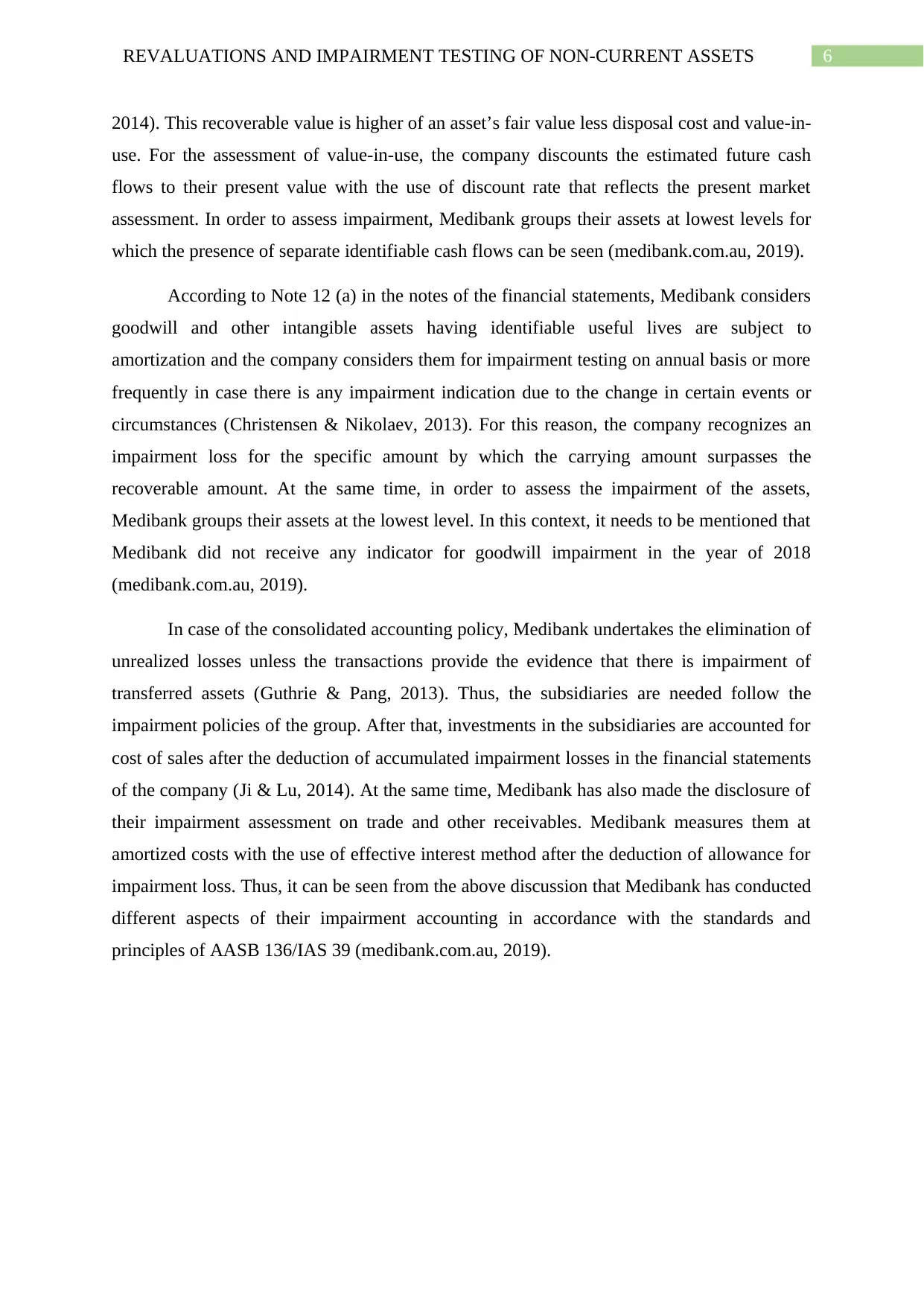
6REVALUATIONS AND IMPAIRMENT TESTING OF NON-CURRENT ASSETS
2014). This recoverable value is higher of an asset’s fair value less disposal cost and value-in-
use. For the assessment of value-in-use, the company discounts the estimated future cash
flows to their present value with the use of discount rate that reflects the present market
assessment. In order to assess impairment, Medibank groups their assets at lowest levels for
which the presence of separate identifiable cash flows can be seen (medibank.com.au, 2019).
According to Note 12 (a) in the notes of the financial statements, Medibank considers
goodwill and other intangible assets having identifiable useful lives are subject to
amortization and the company considers them for impairment testing on annual basis or more
frequently in case there is any impairment indication due to the change in certain events or
circumstances (Christensen & Nikolaev, 2013). For this reason, the company recognizes an
impairment loss for the specific amount by which the carrying amount surpasses the
recoverable amount. At the same time, in order to assess the impairment of the assets,
Medibank groups their assets at the lowest level. In this context, it needs to be mentioned that
Medibank did not receive any indicator for goodwill impairment in the year of 2018
(medibank.com.au, 2019).
In case of the consolidated accounting policy, Medibank undertakes the elimination of
unrealized losses unless the transactions provide the evidence that there is impairment of
transferred assets (Guthrie & Pang, 2013). Thus, the subsidiaries are needed follow the
impairment policies of the group. After that, investments in the subsidiaries are accounted for
cost of sales after the deduction of accumulated impairment losses in the financial statements
of the company (Ji & Lu, 2014). At the same time, Medibank has also made the disclosure of
their impairment assessment on trade and other receivables. Medibank measures them at
amortized costs with the use of effective interest method after the deduction of allowance for
impairment loss. Thus, it can be seen from the above discussion that Medibank has conducted
different aspects of their impairment accounting in accordance with the standards and
principles of AASB 136/IAS 39 (medibank.com.au, 2019).
2014). This recoverable value is higher of an asset’s fair value less disposal cost and value-in-
use. For the assessment of value-in-use, the company discounts the estimated future cash
flows to their present value with the use of discount rate that reflects the present market
assessment. In order to assess impairment, Medibank groups their assets at lowest levels for
which the presence of separate identifiable cash flows can be seen (medibank.com.au, 2019).
According to Note 12 (a) in the notes of the financial statements, Medibank considers
goodwill and other intangible assets having identifiable useful lives are subject to
amortization and the company considers them for impairment testing on annual basis or more
frequently in case there is any impairment indication due to the change in certain events or
circumstances (Christensen & Nikolaev, 2013). For this reason, the company recognizes an
impairment loss for the specific amount by which the carrying amount surpasses the
recoverable amount. At the same time, in order to assess the impairment of the assets,
Medibank groups their assets at the lowest level. In this context, it needs to be mentioned that
Medibank did not receive any indicator for goodwill impairment in the year of 2018
(medibank.com.au, 2019).
In case of the consolidated accounting policy, Medibank undertakes the elimination of
unrealized losses unless the transactions provide the evidence that there is impairment of
transferred assets (Guthrie & Pang, 2013). Thus, the subsidiaries are needed follow the
impairment policies of the group. After that, investments in the subsidiaries are accounted for
cost of sales after the deduction of accumulated impairment losses in the financial statements
of the company (Ji & Lu, 2014). At the same time, Medibank has also made the disclosure of
their impairment assessment on trade and other receivables. Medibank measures them at
amortized costs with the use of effective interest method after the deduction of allowance for
impairment loss. Thus, it can be seen from the above discussion that Medibank has conducted
different aspects of their impairment accounting in accordance with the standards and
principles of AASB 136/IAS 39 (medibank.com.au, 2019).
Paraphrase This Document
Need a fresh take? Get an instant paraphrase of this document with our AI Paraphraser
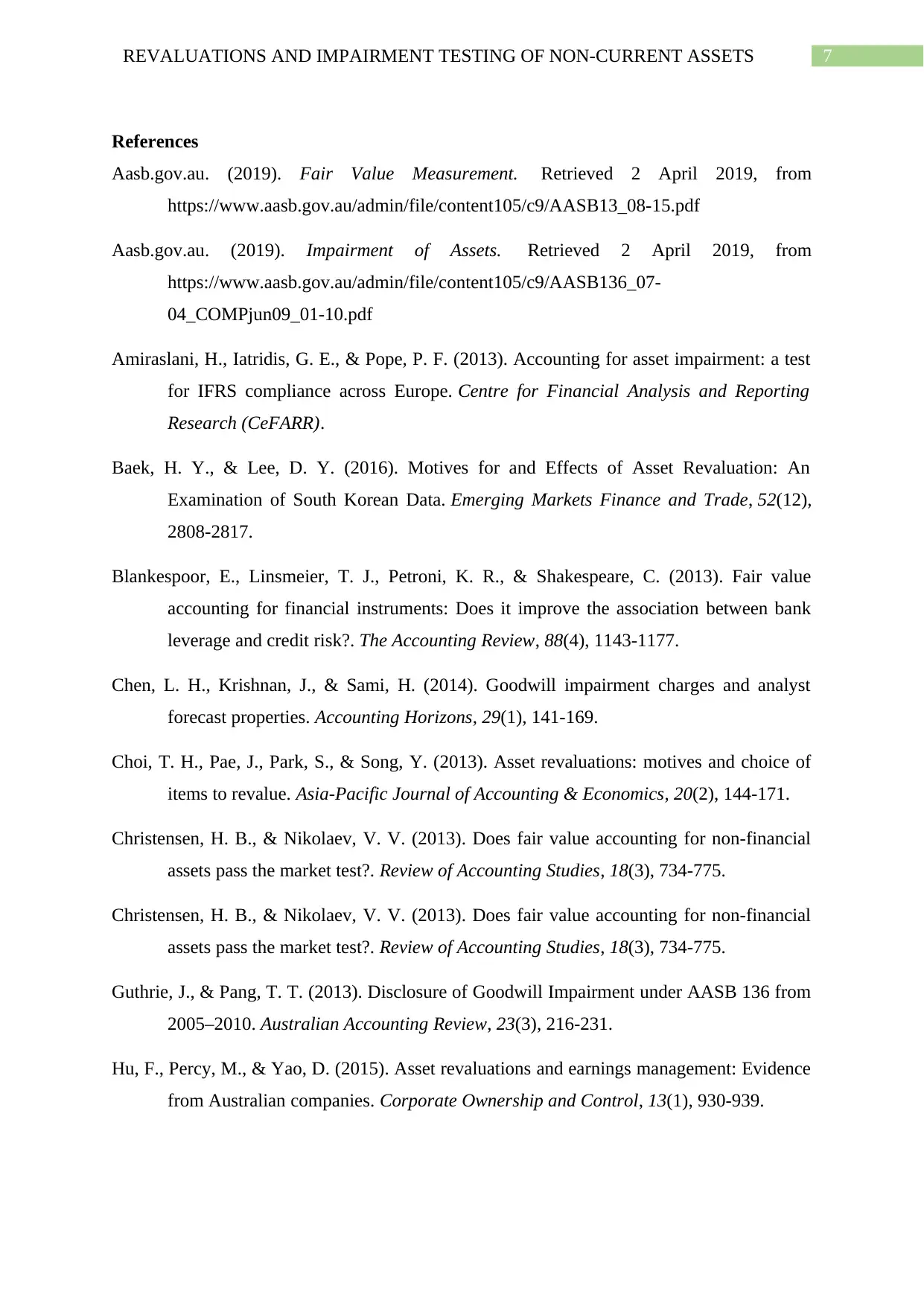
7REVALUATIONS AND IMPAIRMENT TESTING OF NON-CURRENT ASSETS
References
Aasb.gov.au. (2019). Fair Value Measurement. Retrieved 2 April 2019, from
https://www.aasb.gov.au/admin/file/content105/c9/AASB13_08-15.pdf
Aasb.gov.au. (2019). Impairment of Assets. Retrieved 2 April 2019, from
https://www.aasb.gov.au/admin/file/content105/c9/AASB136_07-
04_COMPjun09_01-10.pdf
Amiraslani, H., Iatridis, G. E., & Pope, P. F. (2013). Accounting for asset impairment: a test
for IFRS compliance across Europe. Centre for Financial Analysis and Reporting
Research (CeFARR).
Baek, H. Y., & Lee, D. Y. (2016). Motives for and Effects of Asset Revaluation: An
Examination of South Korean Data. Emerging Markets Finance and Trade, 52(12),
2808-2817.
Blankespoor, E., Linsmeier, T. J., Petroni, K. R., & Shakespeare, C. (2013). Fair value
accounting for financial instruments: Does it improve the association between bank
leverage and credit risk?. The Accounting Review, 88(4), 1143-1177.
Chen, L. H., Krishnan, J., & Sami, H. (2014). Goodwill impairment charges and analyst
forecast properties. Accounting Horizons, 29(1), 141-169.
Choi, T. H., Pae, J., Park, S., & Song, Y. (2013). Asset revaluations: motives and choice of
items to revalue. Asia-Pacific Journal of Accounting & Economics, 20(2), 144-171.
Christensen, H. B., & Nikolaev, V. V. (2013). Does fair value accounting for non-financial
assets pass the market test?. Review of Accounting Studies, 18(3), 734-775.
Christensen, H. B., & Nikolaev, V. V. (2013). Does fair value accounting for non-financial
assets pass the market test?. Review of Accounting Studies, 18(3), 734-775.
Guthrie, J., & Pang, T. T. (2013). Disclosure of Goodwill Impairment under AASB 136 from
2005–2010. Australian Accounting Review, 23(3), 216-231.
Hu, F., Percy, M., & Yao, D. (2015). Asset revaluations and earnings management: Evidence
from Australian companies. Corporate Ownership and Control, 13(1), 930-939.
References
Aasb.gov.au. (2019). Fair Value Measurement. Retrieved 2 April 2019, from
https://www.aasb.gov.au/admin/file/content105/c9/AASB13_08-15.pdf
Aasb.gov.au. (2019). Impairment of Assets. Retrieved 2 April 2019, from
https://www.aasb.gov.au/admin/file/content105/c9/AASB136_07-
04_COMPjun09_01-10.pdf
Amiraslani, H., Iatridis, G. E., & Pope, P. F. (2013). Accounting for asset impairment: a test
for IFRS compliance across Europe. Centre for Financial Analysis and Reporting
Research (CeFARR).
Baek, H. Y., & Lee, D. Y. (2016). Motives for and Effects of Asset Revaluation: An
Examination of South Korean Data. Emerging Markets Finance and Trade, 52(12),
2808-2817.
Blankespoor, E., Linsmeier, T. J., Petroni, K. R., & Shakespeare, C. (2013). Fair value
accounting for financial instruments: Does it improve the association between bank
leverage and credit risk?. The Accounting Review, 88(4), 1143-1177.
Chen, L. H., Krishnan, J., & Sami, H. (2014). Goodwill impairment charges and analyst
forecast properties. Accounting Horizons, 29(1), 141-169.
Choi, T. H., Pae, J., Park, S., & Song, Y. (2013). Asset revaluations: motives and choice of
items to revalue. Asia-Pacific Journal of Accounting & Economics, 20(2), 144-171.
Christensen, H. B., & Nikolaev, V. V. (2013). Does fair value accounting for non-financial
assets pass the market test?. Review of Accounting Studies, 18(3), 734-775.
Christensen, H. B., & Nikolaev, V. V. (2013). Does fair value accounting for non-financial
assets pass the market test?. Review of Accounting Studies, 18(3), 734-775.
Guthrie, J., & Pang, T. T. (2013). Disclosure of Goodwill Impairment under AASB 136 from
2005–2010. Australian Accounting Review, 23(3), 216-231.
Hu, F., Percy, M., & Yao, D. (2015). Asset revaluations and earnings management: Evidence
from Australian companies. Corporate Ownership and Control, 13(1), 930-939.
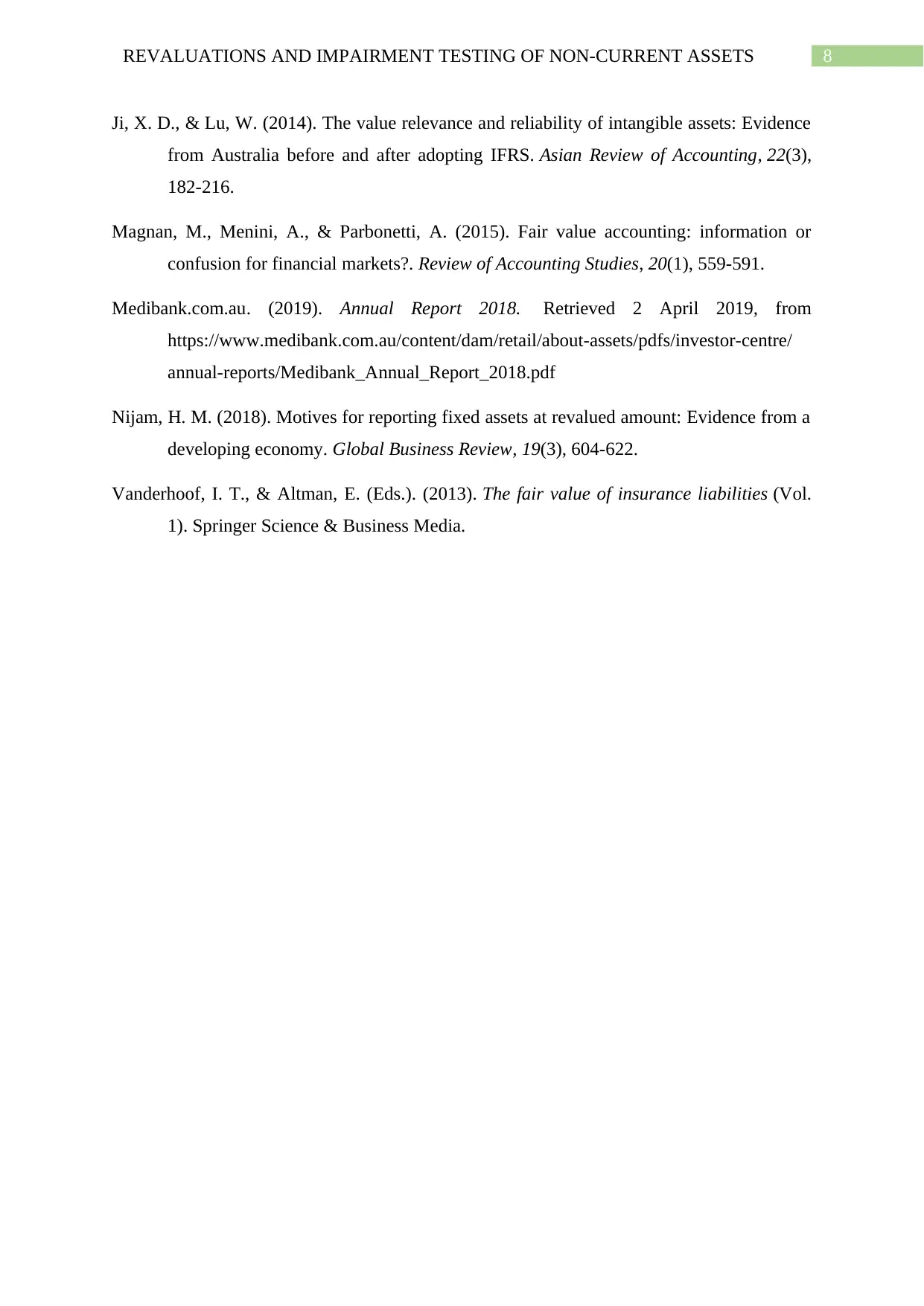
8REVALUATIONS AND IMPAIRMENT TESTING OF NON-CURRENT ASSETS
Ji, X. D., & Lu, W. (2014). The value relevance and reliability of intangible assets: Evidence
from Australia before and after adopting IFRS. Asian Review of Accounting, 22(3),
182-216.
Magnan, M., Menini, A., & Parbonetti, A. (2015). Fair value accounting: information or
confusion for financial markets?. Review of Accounting Studies, 20(1), 559-591.
Medibank.com.au. (2019). Annual Report 2018. Retrieved 2 April 2019, from
https://www.medibank.com.au/content/dam/retail/about-assets/pdfs/investor-centre/
annual-reports/Medibank_Annual_Report_2018.pdf
Nijam, H. M. (2018). Motives for reporting fixed assets at revalued amount: Evidence from a
developing economy. Global Business Review, 19(3), 604-622.
Vanderhoof, I. T., & Altman, E. (Eds.). (2013). The fair value of insurance liabilities (Vol.
1). Springer Science & Business Media.
Ji, X. D., & Lu, W. (2014). The value relevance and reliability of intangible assets: Evidence
from Australia before and after adopting IFRS. Asian Review of Accounting, 22(3),
182-216.
Magnan, M., Menini, A., & Parbonetti, A. (2015). Fair value accounting: information or
confusion for financial markets?. Review of Accounting Studies, 20(1), 559-591.
Medibank.com.au. (2019). Annual Report 2018. Retrieved 2 April 2019, from
https://www.medibank.com.au/content/dam/retail/about-assets/pdfs/investor-centre/
annual-reports/Medibank_Annual_Report_2018.pdf
Nijam, H. M. (2018). Motives for reporting fixed assets at revalued amount: Evidence from a
developing economy. Global Business Review, 19(3), 604-622.
Vanderhoof, I. T., & Altman, E. (Eds.). (2013). The fair value of insurance liabilities (Vol.
1). Springer Science & Business Media.
⊘ This is a preview!⊘
Do you want full access?
Subscribe today to unlock all pages.

Trusted by 1+ million students worldwide
1 out of 9
Related Documents
Your All-in-One AI-Powered Toolkit for Academic Success.
+13062052269
info@desklib.com
Available 24*7 on WhatsApp / Email
![[object Object]](/_next/static/media/star-bottom.7253800d.svg)
Unlock your academic potential
Copyright © 2020–2025 A2Z Services. All Rights Reserved. Developed and managed by ZUCOL.




